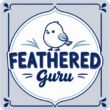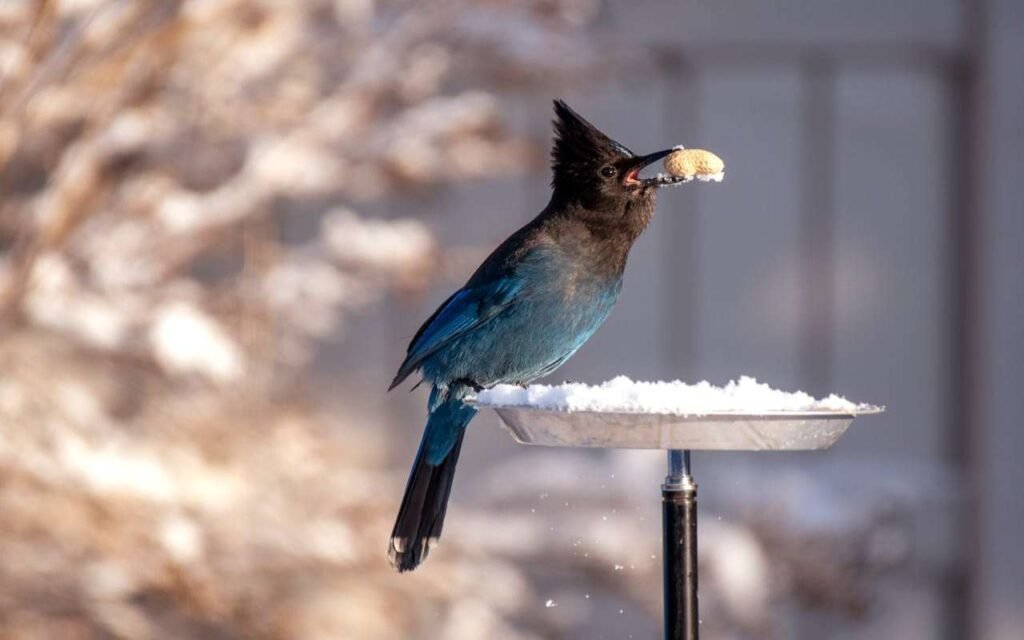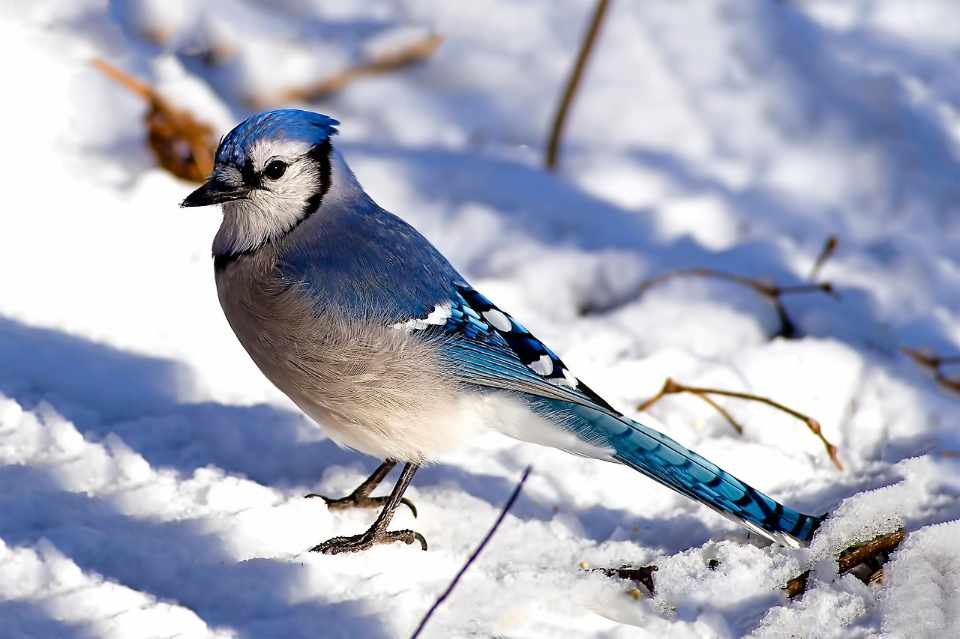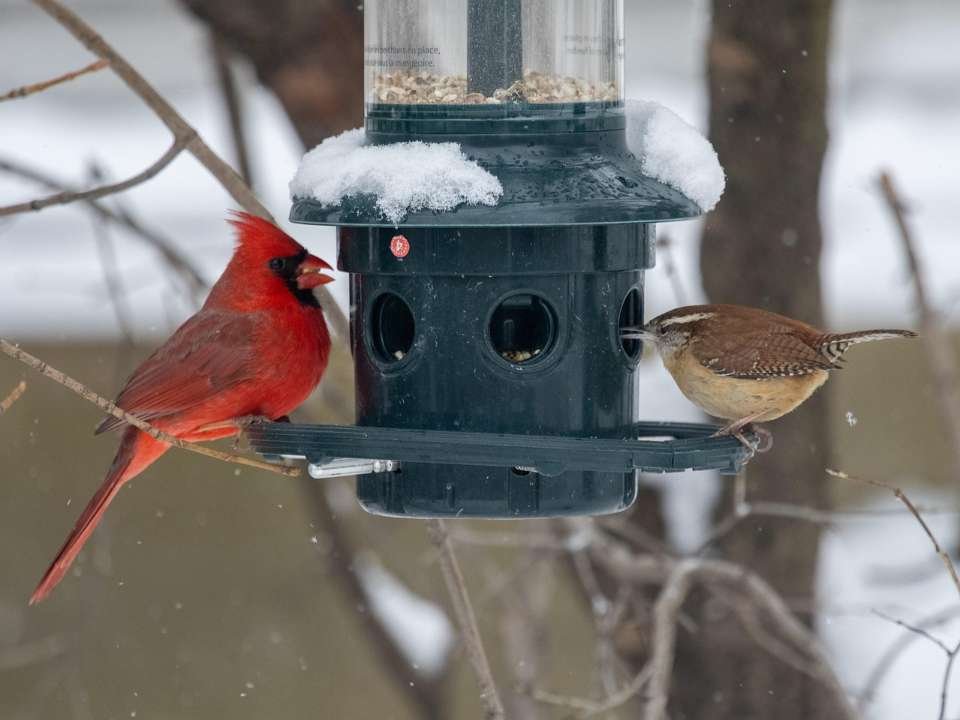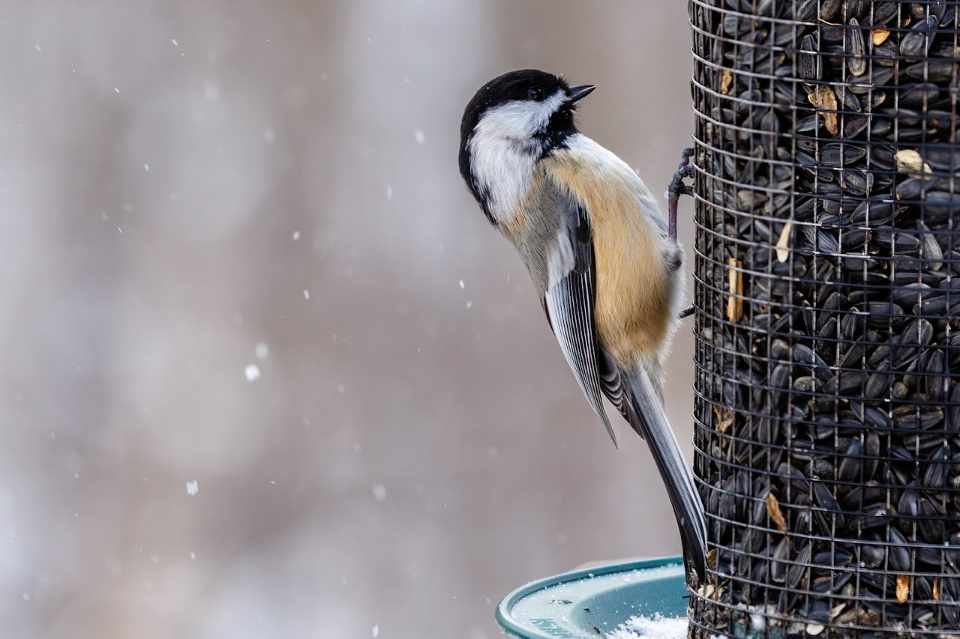Feeding birds in winter doesn’t have to be tricky, you can turn your backyard from a frozen wasteland into the neighborhood’s hottest bird café 😅. I learned this the hard way during my first winter of bird feeding, which ended up an expensive lesson, apparently, birds have standards too.
It’s not just about tossing some seeds outside and hoping for the best. Providing a consistent food source keeps your feathered friends coming back while helping them survive the harsh winter months.
Why Winter Bird Feeding Makes a Real Difference
Winter survival rates for birds increase dramatically when humans provide consistent supplemental feeding. Natural food sources become scarce, buried under snow, or simply don’t exist during cold months.
According to a systematic review by Conservation Evidence, multiple studies in Europe show that supplemental feeding improves winter survival, body mass, and breeding performance for certain farmland species across replicated and controlled trials.
Birds burn significantly more calories maintaining their body temperature in winter. A single chickadee can lose 10% of its body weight overnight just staying warm. Your bird feeder becomes their lifeline during these energy-demanding months.
Consistent feeding stations also help birds establish reliable foraging patterns. They remember dependable food sources and return daily, often bringing friends and family members along for the feast.
I remember watching a cardinal family discover my feeder during a particularly brutal February. Within a week, I counted twelve cardinals visiting daily. Word travels fast in the bird community when you’re serving quality meals.
Essential Winter Bird Foods That Actually Work
Not all bird food performs equally in winter conditions. Cold temperatures, moisture, and hungry birds require specific high-energy seed mixes and feeding strategies.
High-Fat Content Seeds
Sunflower seeds remain the gold standard for winter feeding. Black oil sunflower seeds contain higher fat content than striped varieties, providing maximum calories per seed.
According to a large-scale winter feeder study published in Avian Research, sunflower seeds were the most preferred food, far surpassing other supplements like millet, animal fats, or berries.
Nyjer seed attracts goldfinches, siskins, and other small songbirds. These tiny seeds pack incredible energy density, perfect for birds facing long, cold nights.
Peanuts offer excellent protein and fat content. I use unsalted, raw peanuts in shell or out—both work great, though in-shell peanuts provide entertainment value as birds work to extract their prize.
Safflower seeds resist spoilage in wet conditions better than many alternatives. Cardinals and chickadees love them, while squirrels typically ignore them (bonus points for pest control).
Winter-Specific Supplemental Foods
Suet becomes crucial during winter months. According to the Royal Society for the Protection of Birds (RSPB), fat-rich foods like suet are essential for helping small birds maintain body heat during freezing conditions.
Commercial suet cakes work well, but homemade suet mixed with seeds, nuts, and dried fruit offers more variety. I make batches every few weeks and store them in the freezer—ironic, considering they’re going outside anyway 🙂
Mealworms attract insect-eating birds like woodpeckers, nuthatches, and wrens. Dried mealworms stay fresh longer in winter storage conditions than live ones.
Foods to Avoid in Winter
Bread products provide little nutritional value and can actually harm birds. They fill up on empty calories instead of eating nutrient-dense foods they need for winter survival.
Salted nuts or seeds can dehydrate birds when fresh water sources freeze. Stick with unsalted options to keep your visitors healthy.
Chocolate, avocado, and fruit pits remain toxic to birds regardless of season. Keep these human treats away from your feeding stations.
Strategic Feeder Placement for Maximum Bird Traffic
Feeder location determines success more than most people realize. I’ve moved the same feeder three times in one yard and seen completely different bird species at each location.
Protection from Weather Elements
Sheltered locations near trees or shrubs provide wind protection while giving birds quick escape routes from predators. Position feeders 10-12 feet from dense cover for optimal safety.
South-facing locations receive maximum sunlight, helping keep seeds dry and preventing ice buildup on feeding platforms.
Elevated positions 5-6 feet high discourage ground predators while remaining accessible to most bird species.
Multiple Feeder Strategies
Different feeder types at varying heights attract diverse bird species. Ground feeders bring in juncos and sparrows, while hanging feeders attract chickadees and finches.
Spacing feeders 10-15 feet apart reduces competition and allows multiple bird species to feed simultaneously without conflict.
Water source proximity increases feeder effectiveness dramatically. Birds need water for drinking and preening, especially when natural sources freeze solid.
Ever notice how some yards attract dozens of bird species while others barely get a few sparrows? It’s all about creating the right microenvironment that meets multiple bird needs in one location.
Feeder Types That Thrive in Winter Conditions
Winter weather destroys cheap feeders faster than you can replace them. Investing in quality, weather-resistant feeders saves money and provides consistent feeding opportunities.
Tube Feeders for Small Seeds
Metal construction withstands freeze-thaw cycles better than plastic alternatives. Look for feeders with drainage holes to prevent seed spoilage from moisture buildup.
Multiple feeding ports accommodate more birds simultaneously, reducing territorial conflicts during high-demand periods.
Removable components make cleaning easier, which becomes crucial when wet conditions promote bacterial growth in stored seeds.
Platform Feeders for Larger Birds
Covered platform feeders protect seeds from snow accumulation while providing landing space for cardinals, jays, and other larger species.
Drainage systems prevent water pooling that leads to seed spoilage and potential disease transmission among visiting birds.
Adjustable roof heights accommodate different bird sizes while providing weather protection for both birds and food.
Specialized Winter Feeders
Suet feeders with cage construction allow woodpeckers, nuthatches, and other clinging birds to feed comfortably while excluding larger birds that might monopolize the food supply.
Ground feeding trays with raised edges contain scattered seeds while allowing easy access for ground-foraging species like juncos and native sparrows.
FYI, heated bird feeders exist but aren’t necessary in most climates. Birds handle cold temperatures better than wet food, so focus on keeping seeds dry rather than warm.
Creating Fresh Water Sources in Freezing Temperatures
Water availability becomes the limiting factor for bird populations faster than food scarcity in many winter environments. Birds need water daily for drinking and maintaining feather condition.
According to the Cornell Lab of Ornithology, reliable access to unfrozen water is one of the most important factors influencing backyard bird survival in winter.
Heated Water Solutions
Electric birdbath heaters maintain liquid water even during sub-zero temperatures. Choose models with thermostats to prevent overheating and reduce energy consumption.
Solar-powered water heaters work in areas with adequate winter sunlight. These units cost less to operate but may not function during extended cloudy periods.
Heated water bowls designed specifically for outdoor use provide reliable water sources without the expense of full birdbath heating systems.
Non-Electric Water Options
Dark-colored containers absorb solar heat more effectively, staying liquid longer during mild freezing conditions.
Shallow water depths (1-2 inches maximum) prevent birds from getting soaked while bathing, which could prove fatal in freezing temperatures.
Wind-protected locations reduce evaporation and prevent water from freezing as quickly as exposed sources.
Timing Your Winter Feeding Schedule
Birds develop feeding routines based on daylight patterns and energy requirements. Understanding these patterns helps you provide food when birds need it most.
Peak Feeding Times
Early morning feeding (sunrise to 2 hours after) coincides with birds replenishing energy stores depleted during cold overnight periods.
Late afternoon feeding (2-3 hours before sunset) allows birds to fuel up for the coming night when they can’t actively feed.
Storm preparation feeding becomes crucial 24-48 hours before predicted severe weather. Birds instinctively increase feeding activity when sensing approaching storms.
Consistent Schedule Benefits
Daily refilling at the same times helps birds incorporate your feeders into their survival routines. Inconsistent feeding can force birds to waste precious energy searching for alternative food sources.
Weekend feeding often sees increased activity as quieter environments make birds more comfortable approaching feeders.
Holiday continuation matters more than you might think. Birds don’t take vacation days from needing calories, even when you’re traveling.
Common Winter Bird Species and Their Preferences
Different winter bird species have specific dietary preferences and feeding behaviors. Tailoring your offerings to attract particular species creates more diverse and interesting backyard bird communities.
Year-Round Residents
Cardinals prefer sunflower seeds and cracked corn, feeding primarily during early morning and late afternoon hours. They bring spectacular color to gray winter landscapes.
Chickadees consume enormous quantities of seeds relative to their tiny size. They cache food in tree bark crevices, making feeders especially valuable during harsh weather.
Blue jays love peanuts and larger seeds. Their intelligence and social behavior make them entertaining feeder visitors, though they can dominate smaller birds.
Woodpeckers require suet and nuts for winter survival. Different woodpecker species prefer different feeder styles, from clinging to platform feeding.
Winter Visitors
Juncos arrive from northern regions seeking milder winter conditions. These ground feeders prefer millet and cracked corn scattered on platform feeders.
Pine siskins appear irregularly during “irruption years” when northern food supplies fail. They love nyjer seed and often travel in large flocks.
Evening grosbeaks occasionally visit feeders in winter, preferring sunflower seeds and showing particular attraction to salt sources.
Maintenance and Hygiene for Winter Feeding Stations
Feeder cleanliness becomes even more critical during winter when wet conditions promote bacterial and fungal growth that can sicken or kill birds.
Regular Cleaning Schedules
Weekly cleaning with 10% bleach solution kills harmful bacteria and prevents disease transmission among bird populations. Rinse thoroughly and allow complete drying before refilling.
According to the Centers for Disease Control (CDC), proper cleaning of bird feeders reduces the spread of salmonella and other pathogens among wild birds.
Seed rotation prevents spoilage by removing old seeds before adding fresh supplies. Moldy or rancid seeds can poison birds and deter future visits.
Ground cleanup removes scattered hulls and waste that attract rodents and create unsanitary conditions beneath feeding areas.
Weather-Related Maintenance
Ice removal from feeders and water sources requires daily attention during freezing conditions. Use warm water rather than salt or chemicals that could harm birds.
Snow clearing around ground feeders maintains access for species that prefer feeding at ground level.
Drainage checks ensure water doesn’t accumulate in seed storage areas where it promotes mold growth and seed spoilage, according to FeederWatch.
Dealing with Common Winter Feeding Challenges
Winter bird feeding presents unique obstacles that don’t exist during warmer months. Anticipating and solving these problems keeps your feeding station running smoothly.
Squirrel Management
Baffles and guards work more effectively than relocating feeders away from trees. Squirrels become more persistent when other food sources disappear under snow cover.
Weight-activated feeders close feeding ports when heavy animals attempt access, though determined squirrels sometimes find workarounds.
Alternative squirrel feeding stations loaded with corn and nuts can redirect squirrel attention away from bird feeders. Yes, you’re essentially paying protection money to squirrels, but it works :/
Weather Protection Strategies
Feeder covers prevent snow accumulation while maintaining bird access to seeds. Simple plastic domes work better than complex mechanical solutions.
Seed storage in waterproof containers prevents moisture damage and extends seed viability during humid winter conditions.
Multiple backup feeders ensure continuous food availability when primary feeders require cleaning, refilling, or weather-related maintenance.
IMO, the biggest mistake new winter bird feeders make is giving up after a few weeks of low activity. Birds need time to discover new food sources, especially when natural foods still remain available.
Creating Long-Term Winter Bird Habitats
Successful winter bird feeding extends beyond just providing food. Creating comprehensive habitat addresses shelter, nesting sites, and year-round support for resident bird populations.
Building a winter bird paradise takes patience, but watching a thriving bird community develop in your backyard makes every frozen morning of feeder maintenance worthwhile. Start small, stay consistent, and prepare for the incredible diversity of winter birds that will soon call your yard their favorite restaurant.
